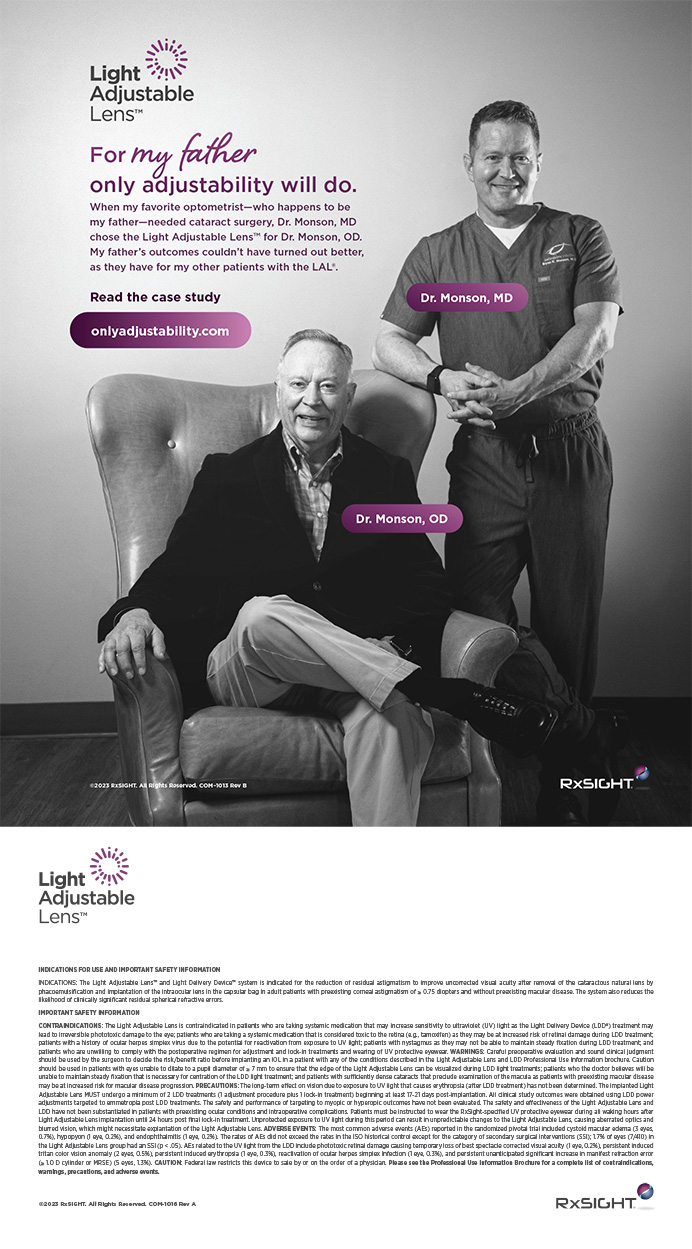Currently, my research relates to refractive IOLs. These include anterior chamber foldable lenses, foldable iris-fixated IOLs, and next-generation multifocal IOLs. Those are the three different areas of FDA clinical trials with which my colleagues and I are currently involved. Regarding non-intraocular refractive surgery, over the past 2 years, we have been refining an in-house algorithm for the correction of presbyopia using the excimer laser.
What is unique about the way you run the Assil Eye Institute in Santa Monica, California?
Patient care continues to be the primary emphasis at the facility. Another focus is clinically relevant research, and a third is peer education of physicians. Over the years, we have headed up the training for many products with various companies, most recently the education and instruction for the Verisyse lens. Along the lines of education, we also have a fellowship training program in refractive and anterior segment surgery. Additionally, charity work is a cornerstone for us. We have historically performed the majority of charitable eye surgeries for the Southern California Lions Eye Institute.
What new surgical technique or technology will affect refractive surgery most?
I believe that multifocal lenses with higher levels of efficacy will have the largest impact on refractive surgery in the next several years. When the next-generation versions of lenses following the Rezoom and the Restor are introduced, they will have a profound effect. For the first time, ophthalmologists will see a possible reduction in the volume of corneal refractive surgery. Their challenge will be addressing halos and glare, but, once that is accomplished with future modifications, it will be a threshold phenomenon. Much to our surprise, the Rezoom procedure is already starting to rival the popularity of LASIK among our patient base. The Centers for Medicare & Medicaid Services' new ruling provides refractive IOLs with a terrain similar to that which LASIK has enjoyed; it essentially puts the lenses into a fee-for-service environment. Doctors and patients are both faced with a choice now, and the degree to which it is properly communicated to patients will determine their decisions. An accommodating IOL will eventually outperform all other lenses currently available.
You have devoted much time and energy to teaching future surgeons and colleagues. What led you to take on the numerous educational positions you have held?
Teaching was always a passion of mine, but it became a more formal pursuit while I was completing my residency. After I set up several charitable surgical clinics in Mexico, my chairman pointed out that many of my efforts would end up with tragic outcomes because no one remained there to conduct proper follow-up. He suggested that, if I really wanted to improve the lives of many people in other parts of the world, I should start training surgeons instead of simply performing surgery, and he was right. If I trained 1,000 surgeons who each performed 1,000 surgeries, I would impact 1 million people. As it turns out, my colleagues and I so far have trained more than 10,000 surgeons in various techniques. I feel that my mission is on the proper path.
My next goal is to build a center of excellence that will not only serve as a clinical research and patient care center, but also as one devoted to physician education. The new eye institute that my colleagues and I are developing will be finished during the next year. It will include an educational theater for physicians that will be equipped with the necessary technology to broadcast lectures and presentations.
What message would you like to impart to your colleagues?
Do not underestimate the value of what you provide for your patients. Because we work in a microsurgical field, the little miracles that we provide to patients seem fairly routine to us. Invariably, I find that eye surgeons undervalue what they are truly giving to their patients. I would encourage my fellow ophthalmologists to stop from time to time and reflect on this idea, or to sit with a patient who wants to tell them about the impact this surgery has made on his life. By listening and really trying to comprehend what it all means, surgeons will get the full benefit of the professional satisfaction that they deserve.


